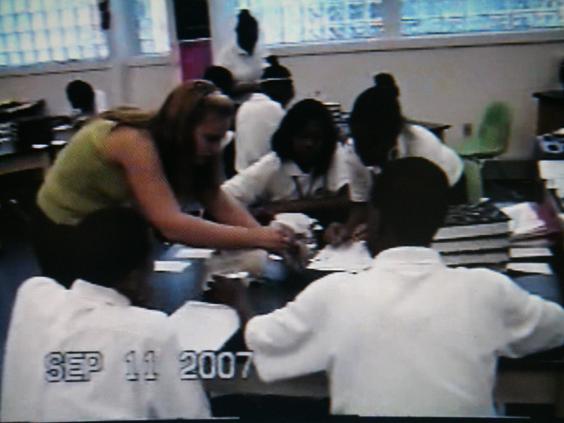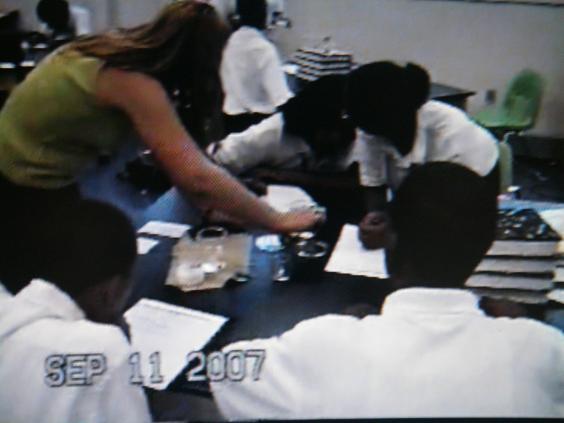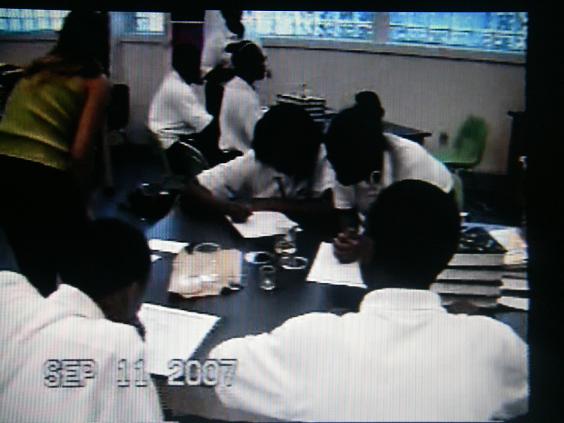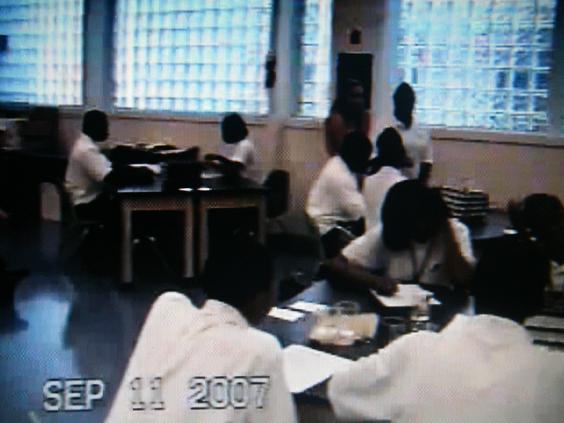
| Home | UPenn E-Portfolio | CHEM
501 |
CHEM 502 |
CHEM 503 |
EDU 536 |
CHEM 505 |
CHEM
506 |
CHEM 507 |
EDU 636 |
CHEM 504 |
CHEM 508 |
| Reflection
#6b |
| <--Previous Reflection Next Reflection--> |
Reflection #6b-Using Video Analysis to Understand Student/Teacher Interactions in my Classroom:
The UPenn class, "Advanced Topics in the Teaching and Learning of Chemistry" has enabled me to be a better professional educator and leader with classmates and coworkers. Furthermore, a key pedagogical underpinning has provided me a framework to make more effective decisions (Enduring Understanding #3 for Chemistry Education). With the use of conversational analysis and a theoretical framework the students' learning of science has been enhanced.
Background:
Currently in my third year of teaching chemistry at Mastery Charter High School, I have been working to improve student/teacher relationships within my classroom. With an urban school environment of 93% African Americans, it has been important to understand how students communicate and interact with me as the teacher and how I can best interact with the students.
During the beginning of the 2007 school year, I had the opportunity to mentor and lead a student teacher from Ursinus College. For eight weeks, the usual planning, preparing, and designing effective instruction was more involved as I explained and described my own pedagogy. I slowly released responsibility to the student teacher by increasing her teaching load from one to three classes. I began to use video analysis to help provide a greater understanding of student/teacher interactions for my own practice. The following conversational analysis shows a mini-lab activity of an eleventh and twelfth grade chemistry class. During this class period, twelve students practiced their observation skills. The teacher is helping out a group of four students at the near table (see Figure 1). Sara, a very outgoing and charismatic student calls out to the teacher in a seemingly rude way. The teacher, Ms. Gaustead, responds as shown below:
Evidence of Student/Teacher Interactions:
Conversational Analysis Transcript-9-11-07 (pdf)
T: Teacher, Ms. Gaustead
Mary/Sara: Students
CAPITAL LETTERS: phrase louder than surrounding talk
(.) : indicates a slight pause, less than 0.10 seconds long
(phrase?) : indicates an uncertain hearing
ºphraseº : indicates utterance produced in low voice
01 S: ALRIGHT,
EXCUSE
ME, UM, TEACHER MA'AM.
02 T: WHAT’S MY NAME?
03 M: (Looking at board) Miss Gow-stead
04 T: (To group close to camera) I guess we are going to have to talk to each other.
05 T: “Gow-stead.” (Teacher turns head to student and phonetically pronounces name, which is spelled on board)
06 M: Miss Gaustead.
07 S: ºGausteadº
(.)
(Approaches
far group that just called out)
08 T: Alright we’re doing good.
09 S: (Do we want to fill this beaker?)
10 T: What did
I say
about every time we see 0.5?
The following meso-level analysis explores the role and identity of the teacher with the students. The socio-cultural connections are vital in understanding the classroom and supporting all students in the learning of science (Enduring Understanding #1 for Chemistry Education). The student teacher, Ms. Gaustead has known the students for two weeks and has interacted with them for approximately a week prior to this video clip.
The video shows many student/teacher interactions, but the most salient interactions are as follows:
Students at the near table are gaining assistance from the teacher when a student, Sara, calls out louder than the surrounding talk. The teacher and several students respond by looking toward the disruptive student (See Figure 2).


a group of students. Her close proximity table. Other students look on, waiting to see
and willingness to get involved communicates what Ms. Gaustead will do.
her interest to the students.
Figure 1. Figure 2.
Immediately, without much hesitation the teacher calls back, "What's my name?" (turn 02) Sara realizes that the teacher might have been offended and attempts to correct her speech. After finishing her interactions with the near table, she proceeds to the far table (Figure 3).


teract and pursue Sara who 'rudely' interrupted. the students with the lab, preferring the learning
of science instead of being easily offended.
Figure 3. Figure 4.
Ms. Gaustead says her name phonetically as spelled on the board, 'Gow-stead' (turn 05). Two students, Sara and Mary respond by correctly saying her name. The teacher encourages the students by telling them what a good job they are doing (turn 08). As a result of the teacher's previous interactions, Sara feels like she can ask her original question. The teacher proceeds to help the group answer a critical question concerning the mini-lab (Figure 4).
Analysis of
Video Using Theoretical Framework:
For this analysis, I have chosen to use
the social-cultural theory framework. This framework is based
upon the premise that learning occurs through socialization.
Social interactions and they way relationships are handled play a key
role in the learning of science. For the students to be
active
members, engaging the material, there must be a sense of cultural
alignment within the classroom.
The teacher plays a vital role in this
cultural alignment. There is cultural and social capital at stake
within the classroom. Ms. Gaustead promoted this positive
cultural
and social capital when she engaged the students at the near table
(Figure 1) and pursued the student who called out (Figure 3). After
the rude interruption (turn 01), the teacher's
response, 'What's my name?' (turn 02) is the agency, or the
ability to
enact culture. The other students in class waited to
see how the teacher would respond. Her response was firm and
correcting, yet she was not easily offended. By addressing the
interruption, she shapes future interactions and establishes a
structure for appropriate social behavior and an interest in science
learning. She
emphasized the importance of authority and respect by addressing the
correct pronunciation of her name. Her method of handling the
mispronunciation, built social capital in the classroom.
Sewell (1992) speaks about the dialectical relationship between agency
and structure. He notes, "Agency requires access to the resources
of a field and the cultural capital needed to appropriate them."
The field of a mini-lab enabled the teacher to enact culture through a
brief interaction with students. After the correction
of her name, the teacher positively pursues the students, 'Alright
we're doing good' (turn 08). The correction becomes an important structure to
the development of mutual respect. As a result of
the capital
established in the previous interaction, the student feels free to ask
the question she originally intended, 'Do we want to fill this beaker?'
(turn 09). Now
aware of the appropriate structure, students are
able to act within the classroom culture, therefore, continuing their
learning of science. The learning of science for Ms.
Gaustead
becomes more important than being easily offended by the student who
called out (turn 02).
Application To My Vision of
Science Education:
The respect students have for authority
reflects positive student/teacher social interactions.
With increased cultural alignment and improved teacher
relationships, students can perform well in urban educational
settings. According to Tobin (2006), teachers who
learn how to interact successfully with students will be able to
promote
a positive culture (cultural alignment), which affords science
education. Through
the UPenn Science Teacher Institute, I have learned that the teaching
of science is much more than content knowledge or the particular
presentation of material (whether driven by inquiry or lecture).
The
teaching of science includes how students learn and what motivates them
to learn. Without positive social interactions with their
teacher,
certain students will reject any form of instruction.
Student/teacher
relationships, as a result of cultural alignment, provide important
pedagogical tools for the teacher.
Summary: Application to
UPenn STI
E-Portfolio Rubric and EDU 636 Enduring Understandings:
- Enduring Understanding #3-The theoretical underpinnings of pedagogy...provide frameworks that enable the teacher to make effective decisions about...teaching strategies and to conduct action research.
- I have been able to make more effective decisions when I interact with my students based on this action research in my classroom. The video analysis has enabled me to see how important student/teacher interactions are to the teaching and learning of science. Without a theoretical framework of socio-cultural theory, I would not have been able to see valuable data and put correct interpretation with that data.
- Enduring Understanding #1-Understanding the connections between socio-cultural and other educational theories and the teaching and learning practices...to support and guide all students in making sense of scientific ideas.
- As stated before, I have now been able to understand the
value of cultural alignment and social/cultural capital within the
classroom. With the improved student/teacher relationships,
students can perform better in an urban setting. As a result,
scientific ideas within my classroom are understood and pursued by the
students.
- Reflective Practice-E-Portfolio Rubric Item
- Spending time and energy to carefully analyze visual and verbal student/teacher interactions has been a valuable tool for my ongoing reflective practice. As seen with the video analysis above, I am able to reflect on my classroom routines and use data to change the way I interact with students. This constant change is at the heart of my reflective practice.
- Science Education Theory and Literature-E-Portfolio Rubric Item
- Socio-cultural theory and the dialectical relationship between agency and structure have been vital theoretical frameworks to help me understand the student/teacher relationships within my classroom. This science educational theory has been brought to life after using conversational analysis. Reading literature from authors such as Sewell (1992) and Tobin (2006) have been influential in viewing my classroom with a different lens.
Sewell, W.H. American Journal of Sociology. 1992, 98, 1-29.
Tobin, K. Cultural Studies of Science Education. 2006, 1, 219-252.